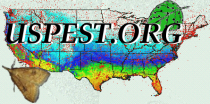
IPM degree-days and models - Frequently Asked Questions (FAQ)
IPM weather data/degree-day website: uspest.org/wea

1. What are degree-days and what are they used for?
Degree-days (DDs) (which are also referred to as "growing degree-days", "heat units" or "thermal units") are the summation of temperature over time. DDs are comonly used as a measure of "physiological time" or age, at least for ectothermic organisms ("cold blooded", including most non-vertebrate forms of life). Usually degree-days are only counted above a lower temperature threshold, sometimes an upper threshold is also used. Degree-day concepts are explained in detail at the UC Davis website:
http://www.ipm.ucdavis.edu/WEATHER/ddconcepts.html#Degree-day concepts. Degree-days are commonly used in agriculture and natural resources management to predict events and to time management activities, such as when to sample or control a pest problem. Note that we avoid using the largely synonomous term "growing degree-day" (GDD) due to the distinction that the term is imprecise, because heat-units are better at predicting development than growth, which is also highly dependent on nutrient and moisture intake. However, the term GDD is in common usage in many agricultural regions. Often the term is used to imply "simple average degree-days" using a lower threshold of 50F. Note also the the term "day-degree" is interchangeable with the term "degree-day" (which we prefer to use for reasons of convention).
2. How are degree-days calculated?
Various simple and complicated methods all more or less try to integrate the temperature between thresholds over a one-day interval. While actual or precise degree-days can be calculated with certain devices and weather station software (such as at one-minute intervals), these are seldom used. Instead, the daily MAX and MIN temperatures are normally used to estimate DDs using a formula.
A simple average degree-day uses the daily MAX and MIN, a lower threshold TLOW (such as 50 degrees Fahrenheit), and the formula: ((MAX + MIN) / 2) - TLOW. So for a MAX and MIN of 100 and 40, and TLOW of 50, we get ((100 + 40) / 2) - 50 or 70 - 50 = 20 degree-days for one day. Degree-days are accumulated by adding over consecutive days.
A growing degree-day (as defined for corn development) is similar except that the lower threshold is substituted for the MIN (if the MIN is the lesser of the two), and an upper threshold is substituted for the MAX (if the MAX is the greater of the two). For the above MAX and MIN and TLOW, and upper threshold THI of 86 we get ((86 + 50) / 2) - 50 or 68 - 50 = 18 growing dds.
Other popular formulae include single and double triangulation, single and double sine curve, and real time degree-days. All of these require more complex calculations. Most degree-day models should use the method that they were derived (or validated) with, but it generally is OK to substitute the single for the double calculation methods. Because degree-day calculations can be tedious and data are not always available, we have most methods online in the form of a calculator that are linked to public weather data from thousands of weather stations throughout the US and surrounding areas including much of Canada.
3. What is a biofix?
A biofix is the date to start accumulating degree-days for a particular model. An example is
the first date of catch in a pheromone trap (such as for codling moth). Whatever amount of degree-days have accumulated so far for that year, they are reset to zero at the beginning of the biofix date.
4. How do I interpret degree-day calculations?
Simply, degree-days attempt to take some of the seasonal fluctuations out of predicting
the timing of events that are influenced by temperature. For example, if egg hatch occurs
12-30 days after egg-laying (depending on the temperature), that might take only
only 100 degree-days plus or minus 10. So if you observe the time of egg-laying, you
can add up the degree-days every day thereafter until 90-110 degree-days
accumulate, and you can expect egg hatch to occur. Using degree-days can greatly increase
precision of forecasting critical life stages and management events, and degree-day models can be an integral part of integrated pest management (IPM) programs. They can also help with monitoring of invasive species, by suggesting when an expected arrival time will occur.
5. What pest and crop models are on-line at the website listed above?
Online species models, including thresholds, biofix, calculation method, and key life stage/management events, currently include 160 or more models. Here is a full list of DD models in the USPEST.ORG database. Our hourly weather-driven models are listed at our "MyPest Page".
6. What are degree-day maps and how do I use them?
Degree-day maps take into account elevation, terrain, and local effects to show degree-day accumulations over a given time period. The degree-day maps at the IPPC website are based on the PRISM expert system model to include these factors, combined with up-to-date calculated degree-days from all available locations (currently over 15,000 publicly shared weather stations). At these locations (within the 48-state conterminous US), we use a geographic information system (GRASS GIS 5.41) to compute the difference between the two estimates (PRISM based and real time), interpolate these differences to produce a correction layer, and add this correction layer to the PRISM maps to produce near real-time degree-day maps. PRISM maps use a 800m cell, and are considered medium resolution with regard to slope, aspect, and microclimate effects.
You can use these maps to estimate for any location, even those without weather stations, degree-day accumulations for the current year, normal (historical average) degree-day accumulations, and the deviations from normal to date for the current year. You can also use the maps to locate stations that have similar weather, in order to best determine a station representative of your own location. An interactive degree-day mapmaker is a feature of the website, which allows end users to create custom DD maps and GIS data for particular regions, thresholds, and dates.
7. What other features are available at the USPEST.ORG/WEA weather data pest and disease models website?
- A Google maps interface to weather stations and degree-day models
- Plant disease and other hourly-driven models relevant to many crops (2020: more than 22 models available)
- Graphs and summary tables of degree-day models
- Documentation and validation status of models (via links listed in model inputs)
- Ability to calculate degree-days for previous years and historical average data
- Forecasts - using 7-day NWS NDFD, 7-month NMME, and recent historical average data
- A file-upload version of the degree-day model that allows anyone to use their own weather data with the models, if formatted correctly

This project funded in part by grants from USDA-NIFA, USDA-APHIS-PPQ, and USDA-RMA-ipmPIPE.
This page updated Feb. 1, 2021
Len Coop, IPPC/Horticulture Dept, OSU, Cordley 2040, Corvallis OR 97331; email: coopl@oregonstate.edu phone: 541-737-5523






